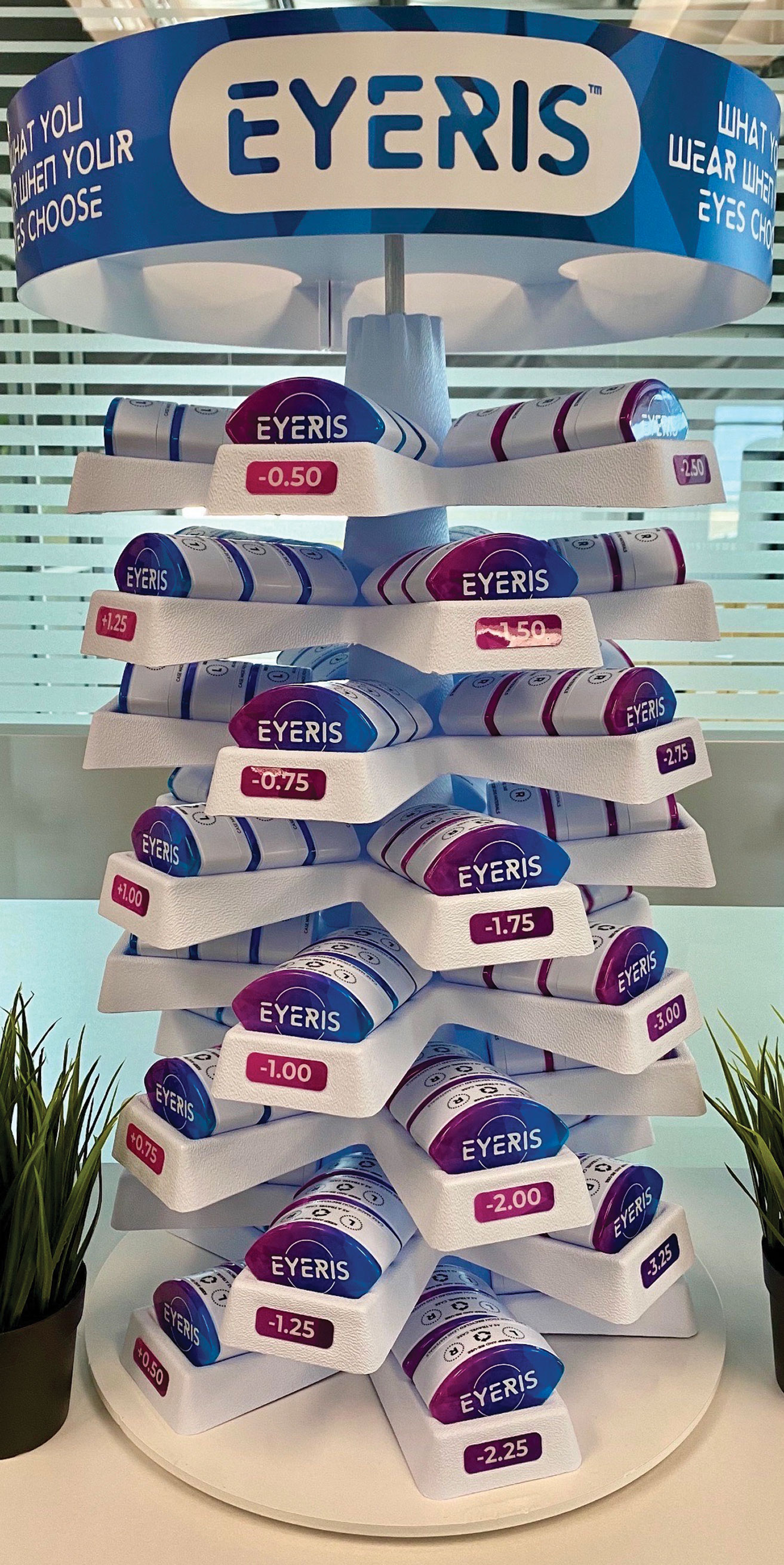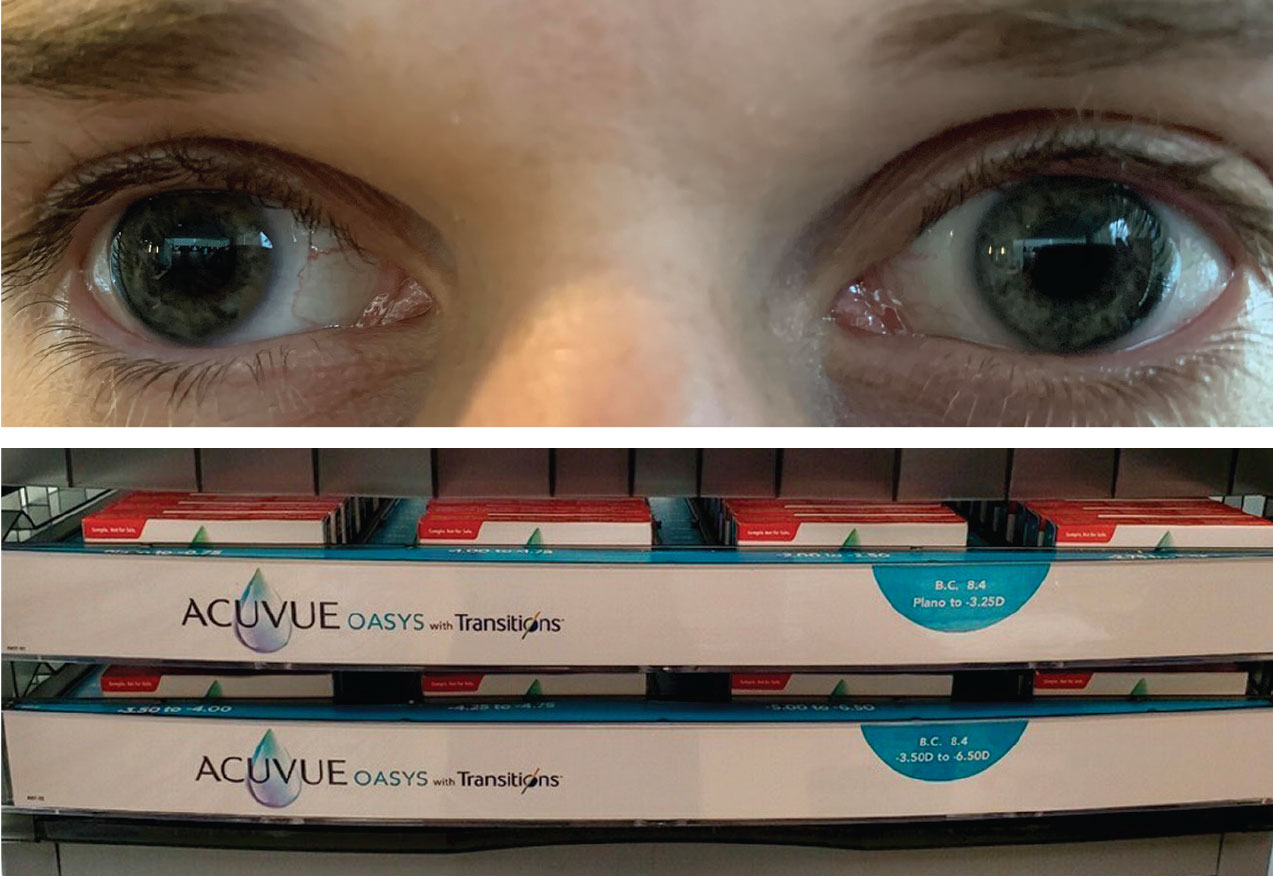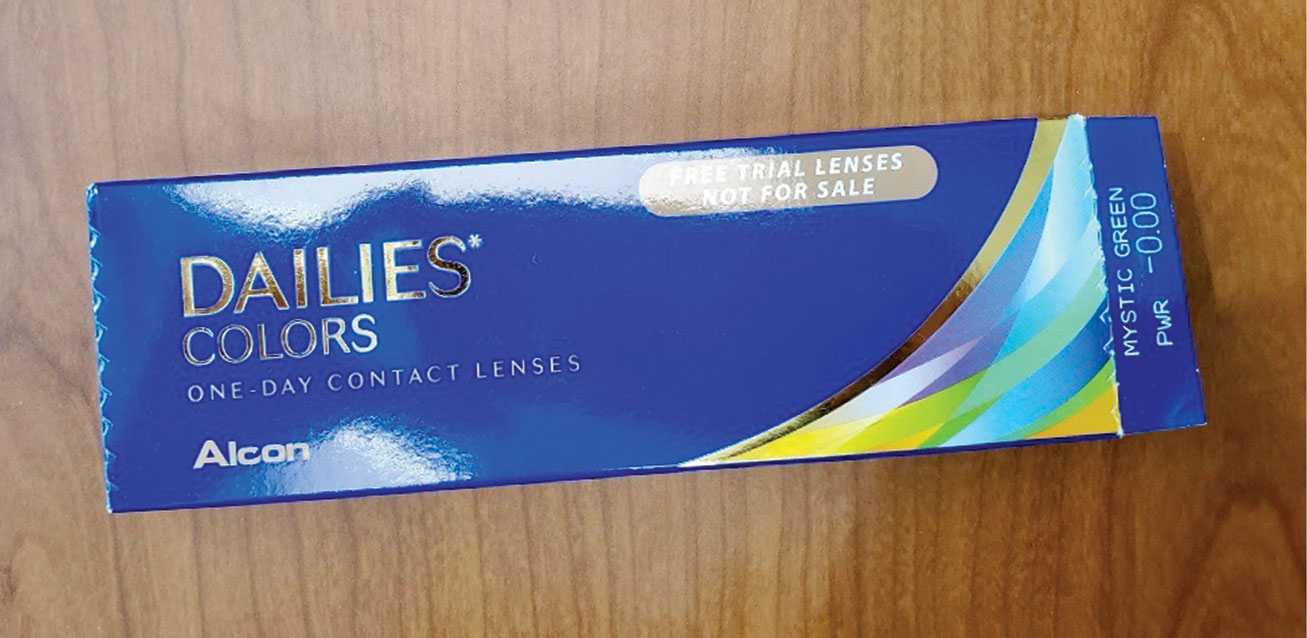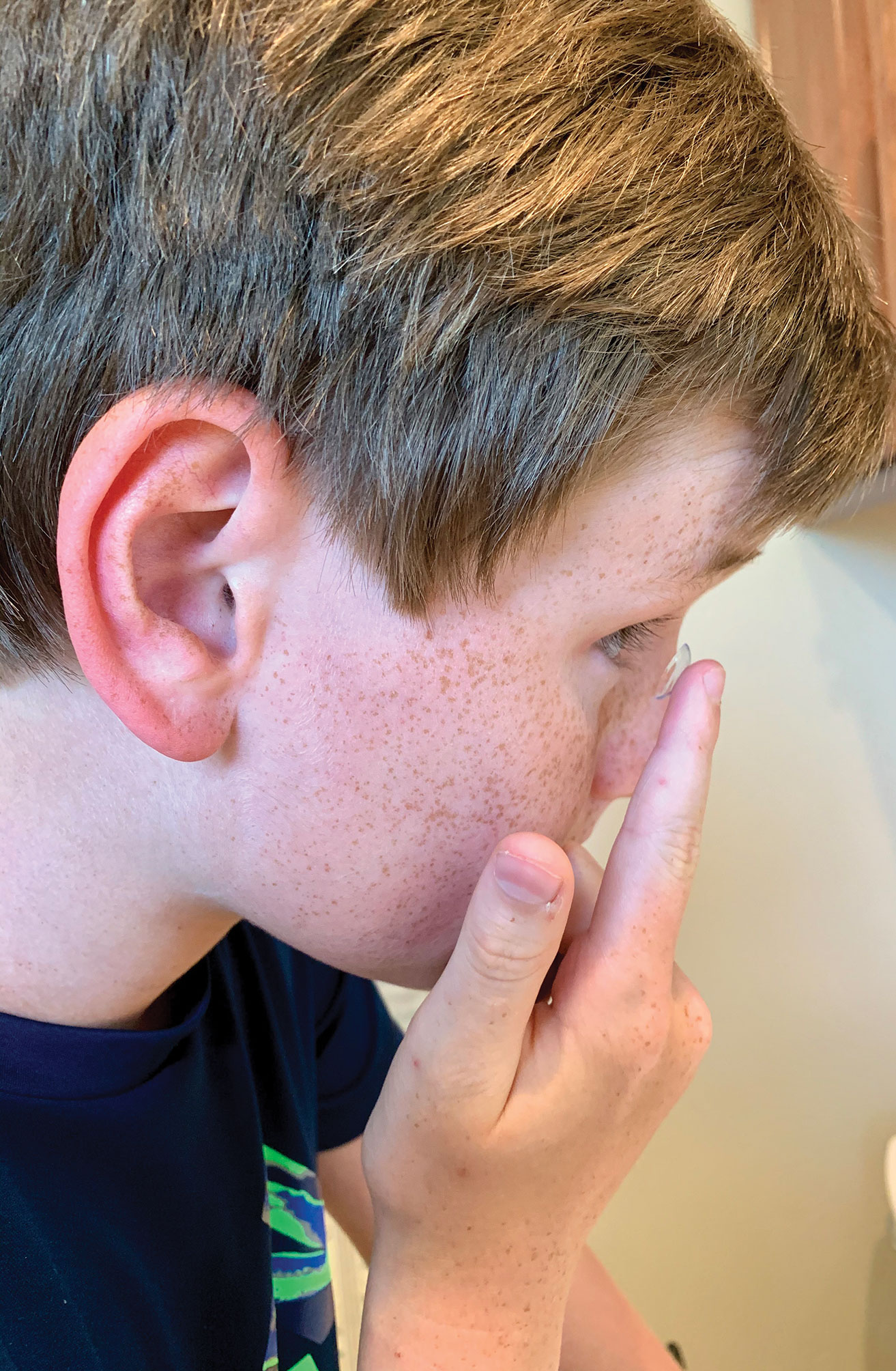44th Annual Contact Lens ReportCheck out the other feature articles in this month's report:- The Building Blocks for a Specialty Contact Lens Practice - Add Multifocals to Your Myopia Toolbox - Don’t Let the Scleral Surge Pass You By |
A specific contact lens recommendation can make all the difference in a patient’s contact lens wearing success. While a robust arsenal of soft contact lens options is available on the market, the practitioner may find it difficult to select the right contact lens for each patient. Even more options have come out in just the last year or two, compounding the problem—and the opportunity. Let’s examine some of the newest state-of-the-art contact lens technologies available today.
 |
| The Eyeris display senses that trial lenses of a particular power have been removed and automatically orders the missing trials. Click image to enlarge. |
Keep It Personal
Commence this process with taking your patient’s history. First, ask if there is a history of contact lens wear. If so, inquire whether they are happy with their lenses or if there is something that could improve their wearing experience. Ask if they would like to improve their vision, stability of vision and comfort. Take note of how long during the day and how often during the week they wear their lenses.
Asking about a history of contact lens wear or discontinuation of contact lens wear is also important. Inquire about the specific issue with prior contact lens wear.
If there is no history of contact lens wear, ask the patient how often they plan to wear their lenses, all-day or only occasionally.
Always take into account the patient’s occupation and daily activities. Inquire if the patient is interested in changing their eye color.
Explain to them that the choice of contact lens can help elevate their vision and comfort throughout their day, and the more specific they can be, the more you can be, too.
Make sure to ask if the patient desires lenses that provide relief when using digital devices or transitioning between different light conditions.
Perhaps there is a need for reading correction. It is also important to take note of any history of dry eyes, allergies or ocular surface disease.
 |
| Novel daily replacement lenses can alleviate issues that drive dropout. Click image to enlarge. |
Dryness and Discomfort
The main reason why patients discontinue contact lens wear is due to poor vision and reduced comfort. Furthermore, approximately 20% of neophyte contact lens wearers discontinue contact lens wear within the first year.1
In the global market, contact lens dropout is approximately equal to the number of new wearers each year.1 The rate of contact lens dropout ranges from 15% to more than 20%.2,3 These rates are incredibly high, especially with the advancements in contact lens materials and designs. In a study that evaluated the impact of contemporary materials and designs on contact lens discontinuation, the primary reasons for stopping were discomfort and dryness; the secondary reasons were red eyes and cost.4
The Tear Film and Ocular Surface Society’s International Workshop on Contact Lens Discomfort recommends multiple approaches to manage this chronic problem.5 Recommendations include eliminating the lens care system by changing to a daily replacement modality, changing the lens care solution or care system, altering the frequency of contact lens replacement, or changing the lens design or material. Tear supplementation may be added, including topical artificial tears or prescription eyedrops, lacrimal inserts and punctal occlusion.
To decide which lens to recommend for each patient, also consider the effects of dry eye disease (DED). This can negatively affect quality of life, with symptoms such as grittiness, foreign body sensation, debilitating ocular pain and photophobia.6 Visual fluctuation and distortion may also occur.
Tear film stability is important in contact lens wearers. If ocular surface disease is present, the quality of the tear film is diminished, increasing contact lens discomfort. Dry eye significantly increases the chance of contact lens drop out.7
For contact lens wearers, especially those with dry eye, it is important to ask which products are being used for the face and eyes. Many cosmetic products contain chemicals that may increase ocular irritation, blepharitis, meibomian gland toxicity and even cause, or exacerbate, DED. It is pertinent to discuss product use with all patients in order to optimize the ocular surface for all contact lens wearers, especially those with dry eye.
Switching to a daily disposable may result in a more comfortable, clean and healthier wear experience. These lenses are thinner and lighter, which may improve dryness and comfort. Also, these lenses are convenient since they do not need to be cleaned or disinfected each night.
Precision1 by Alcon is a recent mainstream daily disposable contact lens option. It can address the common reasons why new wearers discontinue contact lens wear within the first year: poor vision, poor comfort and handling issues. This daily disposable, silicone hydrogel contact lens is available in a new lens material, verofilcon A, with Class 1 ultraviolet blocking capabilities.
Precision1 is made with a thin layer of moisture at the lens surface to help support a stable tear film and deliver lasting visual performance from morning to night, according to company literature.8 The water content at the lens core is 51% and is greater than 80% at the surface.8 As soon as I began fitting patients with this lens, they reported good vision and comfort.
The Eyeris daily contact lens is another new daily disposable, made from hioxifilcon A material. The lens has a Dk/t of 31.25. With the lowest modulus in the industry, it was designed for comfort and to resist end-of-day drying. The powers range from -13.00D to +6.00D in quarter-diopter steps from -7.50D to +4.50D.
Eyeris lenses are available online, but only through the company directly and participating doctors, to guard against improper order filling.
We can also look forward to the imminent arrival of the Infuse daily disposable silicone hydrogel lens from Bausch + Lomb within the next few months, in a new material called kalifilcon A. Infuse has a Dk/t of 134, a water content of 55% and is designed to increase ocular surface homeostasis, according to B+L. The company says the lens’s ability to improve water retention will help encourage long-term wear.
 |
| This patient who complained about eye strain from computer and digital device use did well using Acuvue Oasys with Transitions in both eyes. Click image to enlarge. |
Photosensitivity
Many patients spend long hours on their computers, phones and tablets, as well as reading, driving or playing sports. They often ask for ways to reduce digital eye strain symptoms.
Acuvue Oasys with Transitions (Johnson & Johnson Vision Care) is a new option you can offer these patients. The lenses adapt to changes in light intensity, filter blue light and provide UV protection. Computer and digital device users experience relief as the lenses adjust during use. Acuvue Oasys with Transitions lenses filter up to 15% of light in the blue light range indoors and 55% outdoors.9,10
The lenses protect against indoor light, glare, squinting and fatigue.
Those who are bothered by light and glare indoors or outdoors are good candidates, and many of my patients with headaches and migraines have found relief with these lenses. For night driving, the lenses reduce glare and halos, which my patients with mild to moderate cataracts especially appreciate.
Although these lenses are not designed as a substitute for sunglasses, my patients who are athletes also appreciate the automatic adjustment to different lighting conditions.
I have my patients trial these lenses for 10 to 14 days, then wear their habitual lens for a few days. This process enables the majority of my patients to appreciate the benefits of this technology.
 |
| In-office diagnostic fitting sets of toric multifocal lenses can help you properly fit patients with astigmatism and presbyopia. Click image to enlarge. |
Two Problems, One Lens
The patient’s type and amount of refractive error, astigmatism and presbyopia are critical for contact lens selection. Historically, a high percentage of those who have discontinued lens wear are astigmatic.11 Astigmats remain over-represented in the dropout population, and yet toric contact lenses are still under-prescribed.12 A high proportion of astigmats, including those who have previously dropped out, can be successfully refit with lenses that correct for astigmatism.13 In addition, toric lenses can deliver additional visual quality-of-life benefits.14
In my practice, astigmats specifically complain of blurry or fluctuating vision with digital device use at the end of the day.
In a study of emerging presbyopes, the reasons for drop out were divided between vision and discomfort. Convenience was also noted as a reason for discontinuation.
Contact lenses that correct for astigmatism are the second largest contact lens segment, and nearly one third of all adults who require vision correction could benefit from this design.15 Bausch + Lomb’s Ultra for Astigmatism’s stable toric lens design might benefit these patients. Their latest option, the Ultra Multifocal for Astigmatism contact lenses, introduced in 2019, are an excellent option for patients with refractive error including astigmatism who have presbyopia.
This monthly replacement option combines the Ultra’s lens design with the 3-Zone Progressive multifocal design from the Ultra for Presbyopia lens. These lenses correct for astigmatism and provide good binocular distance and near vision, along with lasting comfort.
These new multifocals are straightforward to fit and provide an excellent option for presbyopic astigmatic patients. Multifocal optics are designed to provide clear vision at all distances, including intermediate vision and enhanced binocular vision. These lenses have been a helpful option for my patients with astigmatism and presbyopia.
Another option to correct both astigmatism and presbyopia is the new Biofinity Toric Multifocal by CooperVision. The company says this lens’s toric geometry is designed to provide a predictable orientation and stable fit for consistently clear vision at all distances with multiple correction zones as well as help reduce dryness and maintain good comfort throughout the day.
 |
| Patients who like color enhancement lenses may not be aware of daily replacement options. Click image to enlarge. |
Color Lenses
This category tends to be a missed opportunity in many practices. I ask every patient if they are interested in changing their eye color, whether on a daily basis or occasionally.
For those interested in changing or enhancing their eye color, Alcon’s new lens line, Dailies Colors, offers a daily replacement option for color enhancement. The company says it designed these for natural-looking color enhancement: the inner ring provides brightness and adds depth, the primary color enhances eye color and the outer ring defines and emphasizes the iris. I find patients like the color options and find that these lenses look natural on the eye.
Myopia
Interest in myopia management continues to grow. Myopia is an emergent public health issue, affecting patients worldwide, particularly in Asia.16 Escalating rates of myopia prevalence are associated with increased risk of retinal detachment, glaucoma, cataract and myopic retinopathy.17-20
In January 2020, CooperVision introduced MiSight, a single-use contact lens FDA approved to slow myopia progression. A clinical trial compared MiSight’s dual-focus optics with a single vision contact lens of the same material and overall geometry.21
Of 109 patients who completed the clinical trial, the unadjusted change in spherical equivalent refraction was -0.73 D (59%) less in the test group compared with the control group. The mean change in axial length was 0.32mm (52%) less in the test group compared with the control group. Of interest, changes in spherical equivalent refraction and axial length were highly correlated.
Children as young as eight years old may be fit with MiSight lenses.
Sharing clinical studies with patients and their parents and explaining long-term risks associated with myopia helps educate them and encourages to choose a myopia management option. Even if a parent is not interested in myopia management, I document the discussion to revisit at a later time.
 |
| Educate parents on myopia management options to select the best-suited option for their child. Click image to enlarge. |
Offer the Best
There are various ways to gather information about new contact lens options. Lectures at live or virtual meetings provide the latest thinking from experts. Published articles can also direct you to the best ways to obtain knowledge about these novel and up-and-coming designs and technologies. Each of your contact lens representatives can also be wealth of knowledge and are superb at providing valuable information.
In my practice, I like to be the first to offer new technologies to my patients. I want my patients to hear about the latest and greatest contact lenses from our practice first. Even if a patient is not receptive to contact lenses or a new type of lens at that time, I document their response to revisit at a later time.
If a patient is unsure if they want to try contact lenses, I provide resources, such as brochures or website information about the lens that might pique their interest. An in-office contact lens diagnostic trial lens fitting may also persuade them. I always give them the option of returning to their prior lenses if they do not like the new ones.
I liken trying new contact lenses to test driving a new car. Even if a person is currently happy with their car, added features and benefits with the newer models may interest them or be a major benefit to them; the same applies for contact lenses.
I like to inform my patients about imminent technologies even before they are available, such as the new Infuse silicone hydrogel lens by Bausch + Lomb, the one-day Acuvue Oasys and other novel daily replacement lenses currently in the pipeline.
Even if my patient is not a candidate for a specific lens, their friend or family member might be. For example, a longstanding patient with keratoconus who wears scleral lenses was in for an appointment. From our conversations, I learned that his daughter was an excellent high school tennis player. I discussed a new contact lens technology that may be perfect for tennis players, which prompted him to bring in his daughter for a contact lens refit for this updated technology. Building this relationship not only helps the patient trust the doctor, it’s a practice building opportunity.
Some practices have talking points that the doctor, technician and staff can use to help explain new contact lens technologies.
Some key phrases include:
- “We have a new, innovative contact lens that provides additional convenience and health benefits.”
- “We have a personalized contact lens that is made just for you. It will provide [insert characteristic] to help with your [vision/comfort needs].
- “You deserve the opportunity to try the best contact lenses that are available. That is why I want you to try [name] contact lens.”
Developing these conversations is beneficial to have a clear, consistent messaging in the practice.
It is incredibly rewarding to have a variety of contact lens options to provide good vision and comfort and provides the opportunity to fulfill a need, solve a problem or both. Narrowing down the right recommendation for each patient requires clear communication and close attention to their vision and comfort goals while optimizing their ocular health.
Dr. Barnett is a principal optometrist at the UC Davis Eye Center in Sacramento, CA. She is a fellow of the American Academy of Optometry, a diplomate of the American Board of Certification in Medical Optometry and a fellow of the British Contact Lens Association. Dr. Barnett serves on the Board of the American Optometric Association Contact Lens and Cornea Section.
Dr. Barnett is a consultant for Alcon, Bausch + Lomb, CooperVision and Johnson & Johnson Vision Care.
| 1. Sulley A, Young G, Hunt C. Retention rates in new contact lens wearers. Eye and Contact Lens 2018; 44:S273-S282. 2. Rumpakis J. New data on contact lens dropouts: an international perspective. Rev Optom. 2010;147(11):37-42. 3. Dumbleton K, Woods CA, Jones LW, et al. The impact of contemporary contact lenses on contact lens discontinuation. Eye Contact Lens. 2013;39(1):92-9. 4. Gayton JL. Etiology, prevalence, and treatment of dry eye disease. Clin Ophthalmol. 2009;3:405-12. 5. Nichols JJ, Willcox MD, Bron AJ, et al. The TFOS International Workshop on Contact Lens Discomfort: executive summary. Invest Ophthalmol Vis Sci. 2013 Oct 18;54(11):TFOS7-13. 6. Paulsen AJ, Cruickshanks KJ, Fischer ME, et al. Dry eye in the beaver dam offspring study: prevalence, risk factors, and health-related quality of life. Am J Ophthalmol. 2014;157(4):799-806. 7. Pucker AD, Jones-Jordan LA, Marx S. Clinical factors associated with contact lens dropout. Cont Lens Anterior Eye. 2019;42(3):318-24. 8. Alcon data on file, 2018. 9. JJV data on file, 2018. Material properties. Acuvue Oasys with Hydraclear Plus, Acuvue Oasys with Transitions Light Intelligent Technology and other reusable contact lenses. Accessed July 21, 2020. 10. JJV data on file, 2018. Definition of Acuvue Oasys with Transitions Light Intelligent Technology. Accessed July 21, 2020. 11. Young G, Veys J, Pritchard N et al. A multicenter study of lapsed contact lens wearers. Ophthal Physiol Opt 2002;22:516-27. 12. Young G, Sulley A and Hunt C. Prevalence of astigmatism in relation to soft contact lens usage. Eye & Contact Lens 2011;37: 20-25. 13. Sulley A, Young G, Lorenz KO, Hunt C. Clinical evaluation of fitting toric soft lenses to current non-users. Ophthal Physiol Opt. 2013;33(2):94-103. 14. Nichols J, Berntsen D, Bickle K et al. A comparison of toric and spherical soft contact lenses on visual quality of life and ease of fitting in astigmatic patients. Paper presentation at Nederlands Contactlens Congress, March 2016. 15. Tiwari P. Bausch Lomb Receives 510(K) clearance From FDA For Bausch Lomb Ultra Multifocal For Astigmatism Contact Lenses. Bausch Consumer. www.bausch.com/our-company/recent-news/artmid/11336/articleid/460/1252018-wednesday. Published December 5, 2018. Accessed July 15, 2020. 16. Wu PC, Huang HM, Yu HJ, Fang PC, Chen CT. Epidemiology of myopia. Asia Pac J Ophthalmol (Phila). 2016;5(6):386–93. 17. Risk factors for idiopathic rhegmatogenous retinal detachment. The Eye Disease Case-control Study Group. Am J Epidemiol. 1993;137(7):749–57. 18. Mitchell P, Hourihan F, Sandbach J, et al. The relationship between glaucoma and myopia: The Blue Mountains Eye Study. Ophthalmology 1999;106(10):2010–5. 19. Lim R, Mitchell P, Cumming RG. Refractive associations with cataract: the Blue Mountains Eye Study. Invest Ophthalmol Vis Sci 1999;40(12):3021–6. 20.Vongphanit J, Mitchell P, Wang JJ. Prevalence and Progression of Myopic Retinopathy in an Older Population. Ophthalmology 2002;109:704–11. 21.Chamberlain P, Piexoto-de-Matos SC, Logan NS, et al. A three-year randomized cinical trial of MiSight lenses for myopia control. Optom Vis Sci. 2019;96(8):556-67. |

